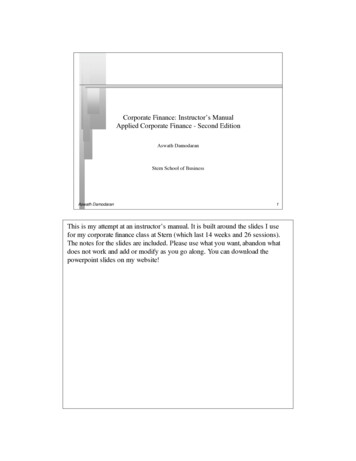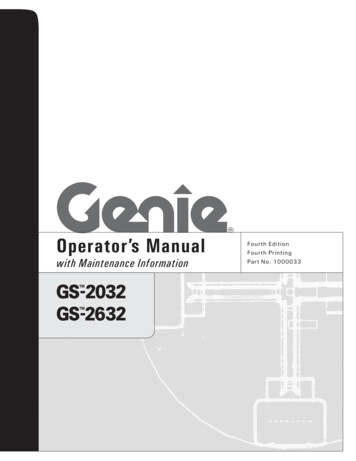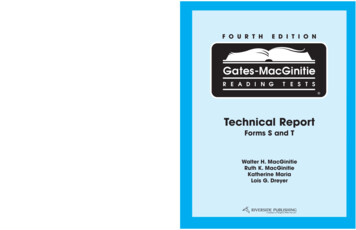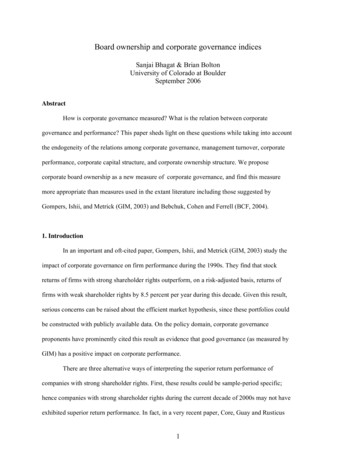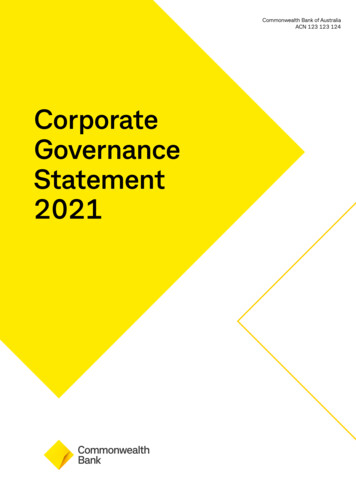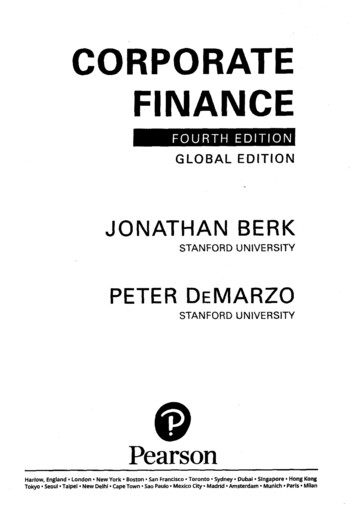
Transcription
CORPORATEFINANCEFOURTH EDITIONGLOBAL EDITIONJONATHANBERKSTANFORD UNIVERSITYPETERDEMARZOSTANFORD UNIVERSITY PearsonMarlow, England London New York * Boston San Francisco Toronto Sydney« Dubai Singapore Hong KongTokyo Seoul Taipei New Delhi CapeTown Sao Paulo Mexico City Madrid Amsterdam Munich Paris Milan
Oetailed ContentsPART 1 INTRODUCTIONhapter 1 The Corporation341.1 The Four Types of Firms 35Sole Proprietorships 35Partnerships 36Limited Liability Companies 37Corporations 37Tax Irnplications for Corporate Entities 38 Corporate Taxation Aroundthe World 391.2 Ownership Versus Control ofCorporations 39The Corporate Management Team 39N INTERVIEW with David Viniar 40The Financial Manager 41 GLOBAL FINANCIAL CRISISThe Dodd-Frank Act 42The Goal of the Firm 42The Firm and Society 43Ethics and Incentives withinCorporations 43m GLOBAL FINANCIAL CRISISThe Dodd-Frank Act on CorporateCompensation and Governance 44 Citizens United v. Federal ElectionCommission 44 Airlines in Bankruptcy 461.3 The Stock Market 46Primary and Secondary Stock Markets 47Traditional Trading Venues 47m INTERVIEW withFrank Hatheway 48New Competition and MarketChanges 49Dark Pools 50MyFinanceLab 51 * Key Terms 51 Further Reading 52 Problems 52Chapter 2 Introduction to FinancialStatement Analysis 552.1 Firms' Disclosure of FinancialInformation 56Preparation of FinancialStatements 56 International Financial ReportingStandards 56 INTERVIEW with Ruth Porat 57Types of Financial Statements 582.2 The Balance Sheet 58Assets 59Liabilities 60Stockholders' Equity 61Market Value Versus Book Value 61Enterprise Value 622.3 The Income Statement 62Earnings Calculations 632.4 The Statement of Cash Flows 64Operating Activity 65Investment Activity 66Financing Activity 662.5 Other Financial StatementInformation 67Statement of Stockholders' Equity 67Management Discussion andAnalysis 68Notes to the FinancialStatements 682.6 Financial Statement Analysis 69Profitability Ratios 69Liquidity Ratios 70Working Capital Ratios 71Interest Coverage Ratios 72Leverage Ratios 73Valuation Ratios 75 COMMON MISTAKEMismatched Ratios 75Operating Returns 76The DuPont Identity 782.7 Financial Reporting in Practica 80Enron 80WorldCom 80Sarbanes-Oxley Act 81* GLOBAL FINANCIAL CRISISBernard Madoff's Ponzi Scheme 82Dodd-Frank Act 82MyFinanceLab 83 Key Terms 84 Further Reading 85 Problems 85 Data Case 925
6ContentsChapter 3 Financial Decision Makingand the Law of One Price 933.1 Valuing Decisions 94Analyzing Costs and Benefits 94Using Market Prices to Determine CashValues 95 When Competitive Market PricesAre Not Available 973.2 Interest Rates and the Time Valueof Money 97The Time Value of Money 97The Interest Rate: An Exchange RateAcross Time 973.3 Present Value and the NPV DecisionRufe 100Net Present Value 100The NPV Decision Rule 101NPV and Cash Needs 1033.4 Arbitrage and the Law of One Price 104Arbitrage 104Law of One Price 1053.5 No-Arbitrage and Security Prices 105Valuing a Security with the Lawof One Price 105 AnOldJoke 109The NPV of Trading Securitiesand Firm Decision Making 109Valuing a Portfolio 110 GLOBAL FINANCIAL CRISISLiquidity and the InformationalRole of Prices 111 Arbitrage in Markets 112Where Do We Go from Here? 113MyFinanceLab 114 Key Terms 115 Further Reading 115 Problems 115Appendix The Price of Risk 119Risky Versus Risk-Free Cash Flows 119Arbitrage with Transactions Costs 124PART 2TIME, MONEY, ANDINTEREST RATESChapter 4 The Time Value of Money1304.1 The Timeline 1314.2 The Three Rules of Time Travel 132Rule 1: Comparing and CombiningValues 1324.34.44.54.64.74.84.9Rule 2: Moving Cash Flows Forwardin Time 133Rule 3: Moving Cash Flows Backin Time 134 Rule of 72 135Applying the Rules of Time Travel 136Valuing a Stream of Cash Flows 138Calculating the Net Present Value 141 USING EXCEL Calculating PresentValues in Excel 142Perpetuities and Annuities 143Perpetuities 143 Historical Examples of Perpetuities 144 COMMON MISTAKE Discount!ng OneToo Many Times 146Annuities 146 Formulaforan Annuity Due 149Growing Cash Flows 149Using an Annuity Spreadsheetor Calculator 154Non-Annual Cash Flows 156Solving for the Cash Payments 157The Internal Rate of Return 160 USING EXCELExcel's IRR Function 163MyFinanceLab 164 Key Terms 165 mFurther Reading 166 Problems 166 sData Case 172Appendix Solving for the Number of Periods 173Chapter 5 Interest Rates 1755.1 Interest Rate Quotes andAdjustments 176The Effective Annual Rate 176 COMMON MISTAKE Using the WrongDiscount Rate in the AnnuityFormula 177Annual Percentage Rates 1785.2 Application: Discount Ratesand Loans 1805.3 The Determinants of InterestRates 181 GLOBAL FINANCIAL CRISIS TeaserRates and Subprime Loans 182Inflation and Real Versus NominalRates 182Investment and Interest RatePolicy 183The Yield Curve and Discount Rates 184
ContentsThe Yield Curve and the Economy 186 COMMON MISTAKE UsingtheAnnuity Formula When DiscountRates Vary by Maturity 186 INTERVIEW withKevin M.Warsh 1885.4 Risk and Taxes 189Risk and Interest Rates 190After-Tax Interest Rates 1915.5 The Opportunrty Cost of Capital 192 COMMON MISTAKE States Diga 3 Trillion Hole by Discountingat the Wrang Rate 193MyFinanceLab 194 Key Terms 195 Further Reading 195 Problems 195 Data Case 200Appendix Continuous Ratesand Cash Flows 202Discount Rates for a ContinuouslyCompounded APR 202Continuously Arriving Cash Flows 202Chapter 6 Valuing Bonds 2056.1 Bond Cash Flows, Prices,and Yields 206Bond Terminology 206Zero-Coupon Bonds 206 GLOBAL FINANCIAL CRISISNegative Bond Yields 208Coupon Bonds 2096.2 Dynamic Behavior of Bond Prices 211Discounts and Premiums 211Time and Bond Prices 212Interest Rate Changes and BondPrices 214 Clean and Dirty Prices for CouponBonds 2156.3 The Yield Curve and BondArbitrage 217Replicating a Coupon Bond 217Valuing a Coupon Bond Using Zero-CouponYields 218Coupon Bond Yields 219Treasury Yield Curves 2206.4 Corporate Bonds 220Corporate Bond Yields 221 Are Treasuries Really Default-FreeSecurities? 221Bond Ratings 223Corporate Yield Curves 22476.5 Sovereign Bonds 224 GLOBAL FINANCIAL CRISIS TheCredit Crisis and Bond Yields 225 GLOBAL FINANCIAL CRISISEuropean Sovereign Debt Yields:A Puzzle 227 INTERVIEW withCarmen M. Reinhart 228MyFinanceLab 229 Key Terms 230 Further Reading 231 Problems 231 Data Case 235 Case Study 236Appendix Forward Interest Rates 238Computing Forward Rates 238Computing Bond Yields from ForwardRates 239PART 3VALUING PROJECTSAND FIRMSChapter ? Investment Decision Rules 2447.1 NPV and Stand-AloneProjects 245Applying the NPV Rule 245The NPV Profile and IRR 245Alternative Rules Versus the NPVRule 246 INTERVIEW with Dick Grannis 2477.2 The Internal Rate of Return Rule 248Applying the IRR Rule 248Pitfall #1: Delayed Investments 248Pitfall #2: Multiple IRRs 249 COMMON MISTAKEIRR Versus the IRR Rule 251Pitfall #3: Nonexistent IRR 2517.3 The Payback Rule 252Applying the Payback Rule 252Payback Rule Pitfalls in Practice 253 Why Do Rules Other Than the NPVRule Persist? 2547.4 Choosing Between Projects 254NPV Rule and Mutually ExclusiveInvestments 254IRR Rule and Mutually ExclusiveInvestments 255The Incremental IRR 256 When Can Returns BeCompared? 257 COMMON MISTAKEIRR and Project Financing 259
8Contents7.5 Project Selection with ResourceConstraints 259Evaluating Projects with DifferentResource Requirements 259Profitability Index 260Shortcomings of the ProfitabilityIndex 262MyFinanceLab 262 i Key Terms 263Further Reading 263 i Problems 263Data Case 269Appendix Computing the NPV Profile UsingExcel's Data Table Function 270Chapter 8 Fundamentals of CapitalBudgeting 2718.1 Forecasting Earnings 272Revenue and Cost Estimates 272Incremental Earnings Forecast 273Indirect Effects on IncrementalEarnings 275 COMMON MISTAKE The OpportunityCost of an Idle Asset 276Sunk Costs and IncrementalEarnings 277 COMMON MISTAKEThe Sunk Cost Fallacy 277Real-World Complexities 2788.2 Determining Free Cash Flowand NPV 279Calculating Free Cash Flowfrom Earnings 279Calculating Free Cash Flow Directly 281Calculating the NPV 282 USING EXCEL Capital BudgetingUsing a Spreadsheet Program 2838.3 Choosing Among Alternatives 284Evaluating ManufacturingAlternatives 284Comparing Free Cash Flows for Cisco'sAlternatives 2858.4 Further Adjustments to FreeCash Flow 286 GLOBAL FINANCIAL CRISISThe American Recovery andReinvestment Act of 2009 2908.5 Analyzing the Project 290Break-Even Analysis 290Sensitivity Analysis 291 INTERVIEW with David Holland 293Scenario Analysis 294 USING EXCEL Project AnalysisUsing Excel 295MyFinanceLab 296 Key Terms 298 Further Reading 298 a Problems 298 Data Case 305Appendix MACRS Depreciation 307Chapter 9 Valuing Stocks 3099.1 The Dividend-Discount Model 310A One-Year Investor 310Dividend Yields, Capital Gains, and TotalReturns 311 The Mechanics of a Short Sale 312A Multiyear Investor 313The Dividend-Discount ModelEquation 3149.2 Applying the Dividend-DiscountModel 314Constant Dividend Growth 314Dividends Versus Investmentand Growth 315 John Burr Williams' Theoryof Investment Value 316Changing Growth Rates 318Limitations of the Dividend-DiscountModel 3209.3 Total Payout and Free Cash FlowValuation Models 320Share Repurchases and the Total PayoutModel 320The Discounted Free CashFlow Model 3229.4 Valuation Based on ComparableFirms 326Valuation Multiples 326Limitations of Multiples 328Comparison with Discounted Cash FlowMethods 329Stock Valuation Techniques: The FinalWord 330 INTERVIEW with Douglas Kehring 3319.5 Information, Competition, and StockPrices 332Information in Stock Prices 332Competition and Efficient Markets 333Lessons for Investors and CorporateManagers 335 Kenneth Cole Productions—WhatHappened? 337The Efficient Markets Hypothesis VersusNo Arbitrage 338MyFinanceLab 338 m Key Terms 340 aFurther Reading 340 m Problems 341 mData Case 346
ContentsPART 4 RISK AND RETURNChapter 10 Capital Markets and the Pricingof Risk 35010.1 Risk and Return: Insights from 89 Yearsof Investor History 35110.2 Common Measures of Riskand Return 354Probability Distributions 354Expected Return 354Variance and Standard Deviation 35510.3 Historical Returns of Stocksand Bonds 357Computing Historical Returns 357Average Annual Returns 359The Variance and Volatility ofReturns 361Estimation Error: Using Past Returnsto Predict the Future 362 Arithmetic Average Returns VersusCompound Annual Returns 36410.4 The Historical Trade Off Between Riskand Return 364The Returns of Large Portfolios 365The Returns of Individual Stocks 36610.5 Common Versus independent Risk 367Theft Versus Earthquake Insurance:An Example 367The Role of Diversification 36810.6 Diversification in StockPortfolios 369Firm-Specific Versus Systematic Risk 370No Arbitrage and the RiskPremium 371 GLOBAL FINANCIAL CRISISDiversification Benefits DüringMarket Crashes 373 COMMON MISTAKE A Fallacyof Long-Run Diversification 37410.7 Measuring Systematic Risk 375Identifying Systematic Risk: The MarketPortfolio 375Sensitivity to Systematic Risk: Beta 37510.8 Beta and the Cost of Capital 378Estimating the Risk Premium 378 COMMON MISTAKEBeta Versus Volatility 378The Capital Asset Pricing Model 380MyFinanceLab 380 i Key Terms 382Further Reading 382 i Problems 382Data Case 3879Chapter 11 Optimal Portfolio Choiceand the Capital Asset PricingModel 38911.1 The Expected Return of aPortfolio 39011.2 The Volatility of a Two-StockPortfolio 391Combining Risks 391Determining Covarianceand Correlation 392 COMMON MISTAKEComputing Variance, Covariance,and Correlation in Excel 394Computing a Portfolio's Varianceand Volatility 39511.3 The Volatility of a Large Portfolio 397Large Portfolio Variance 397Diversification with an Equally WeightedPortfolio 398 INTERVIEW with John Powers 400Diversification with GeneralPortfolios 40111.4 Risk Versus Return: Choosingan Efficient Portfolio 401Efficient Portfolios with Two Stocks 402The Effect of Correlation 404Short Sales 405Efficient Portfolios with ManyStocks 406 NOBEL PRIZES Harry Markowitzand James Tobin 40711.5 Risk-Free Saving and Borrowing 409Investing in Risk-Free Securities 409Borrowing and Buying Stockson Margin 410Identifying the Tangent Portfolio 41111.6 The Efficient Portfolio and RequiredReturns 413Portfolio Improvement: Betaand the Required Return 413Expected Returns and the EfficientPortfolio 41511.7 The Capital Asset Pricing Model 417The CAPM Assumptions 417Supply, Demand, and the Efficiencyof the Market Portfolio 418Optimal Investing: The CapitalMarket Line 41811.8 Determining the Risk Premium 419Market Risk and Beta 419 NOBEL PRIZE William Sharpeon the CAPM 421
10ContentsThe Security Market Line 422Beta of a Portfolio 422Summary of the Capital AssetPricing Model 424MyFinanceLab 424 a Key Terms 427 Further Reading 427 Problems 428 Data Case 434Appendix The CAPM with DifferingInterest Rates 436The Efficient Frontier with Differing Savingand Borrowing Rates 436The Security Market Line with DifferingInterest Rates 436Chapter 12 Estimating the Costof Capital 43912.1 The Equity Cost of Capital 44012.2 The Market Portfolio 441Constructing the Market Portfolio 441Market Indexes 441 Value-Weighted Portfolios andRebalancing 442The Market Risk Premium 44312.3 Beta Estimation 445Using Historical Returns 445Identifying the Best-Fitting Line 447Using Linear Regression 448 Why Not Estimate Expected ReturnsDirectly? 44912.4 The Debt Cost of Capital 449Debt Yields Versus Returns 449 COMMON MISTAKE Using the DebtYield as Its Cost of Capital 450Debt Betas 45112.5 A Project's Cost of Capital 452All-Equity Comparables 452Levered Firms as Comparables 453The Unlevered Cost of Capital 453Industry Asset Betas 45512.6 Project Risk Characteristicsand Financing 457Differences in Project Risk 457 COMMON MISTAKE Adjustingfor Execution Risk 459Financing and the Weighted Average Costof Capital 459 INTERVIEW with Shelagh Glaser 460 COMMON MISTAKEUsing a Single Cost of Capitalin Multi-Divisional Firms 46112.7 Final Thoughts on Usingthe CAPM 462MyFinanceLab 463 KeyTerr. r 465Further Reading 465 * Problem 466Data Case 470Appendix Practica! Considerations WhertForecasting Beta 471Time Horizon 471The Market Proxy 471Beta Variation and Extrapolation 71Outliers 472 COMMON MISTAKE Chang i ithe Index to Improve the Fit'3 USING EXCEL Estimating Be(yUsing Excel 474Other Considerations 475Chapter 13 Investor Behavior and CapitalMarket Efficiency 47713.1 Competition and Capital Markets 478Identifying a Stock's Alpha 478Profiting from Non-Zero Alpha Stocks 47913.2 Information and RationalExpectations 480Informed Versus UninformedInvestors 480Rational Expectations 48113.3 The Behavior of IndividualInvestors 482Underdiversification and PortfolioBiases 482Excessive Trading andOverconfidence 483Individual Behavior and MarketPrices 48513.4 Systematic Trading Biases 485Hanging on to Losers and theDisposition Effect 485 NOBEL PRIZE Kahneman andTversky's Prospect Theory 486Investor Attention, Mood,and Experience 486Herd Behavior 487Implications of BehavioralBiases 48713.5 The Efficiency of the MarketPortfolio 488Trading on News orRecommendations 488 NOBEL PRIZE The 2013 Prize:An Enigma? 490
ContentsThe Performance of Fund Managers 490The Winners and Losers 49313.6 Style-Based Techniques and the MarketEfficiency Debate 494Size Effects 494 INTERVIEW withJonathan Clements 496Momentum 498 Market Efficiency and the Efficiencyof the Market Portfolio 499Implications of Positive-Alpha TradingStrategies 49913.7 Multifactor Models of Risk 501Using Factor Portfolios 502Selecting the Portfolios 503The Cost of Capital with Fama-FrenchCarhart Factor Specification 50413.8 Methods Used in Practice 506Financial Managers 506Investors 507MyFinanceLab 508 Key Terms 510 Further Reading 510 Problems 511Appendix Building a Multifactor Model 517PART 5 CAPITAL STRUCTUREChapter 14 Capital Structure in a PerfectMarket 52014.1 Equity Versus Oebt Financing 521Financing a Firm with Equity 521Financing a Firm with Debtand Equity 522The Effect of Leverage on Riskand Return 52314.2 Modigliani-Miller I: Leverage, Arbitrage,and Firm Value 525MM and the Law of One Price 525Homemade Leverage 525 MM and the Real World 526The Market Value Balance Sheet 527Application: A LeveragedRecapitalization 52814.3 Modigliani-Miller II: Leverage, Risk,and the Cost of Capital 530Leverage and the Equity Costof Capital 530Capital Budgeting and the WeightedAverage Cost of Capital 531 COMMON MISTAKEIs Debt Better Than Equity? 53411Computing the WACC with MultipleSecurities 534Levered and Unlevered Betas 534 NOBEL PRIZE Franco Modiglianiand Merton Miller 53614.4 Capital Structure Fallacies 537Leverage and Earnings per Share 537 GLOBAL FINANCIAL CRISISBank Capital Regulation andthe ROE Fallacy 539Equity Issuances and Dilution 54014.5 MM: Beyond the Propositions 541MyFinanceLab 542 Key Terms 543 Further Reading 543 Problems 544 Data Case 548Chapter 15 Debt and Taxes 55115.1 The Interest Tax Deduction 55215.2 Valuing the Interest Tax Shield 554The Interest Tax Shield and FirmValue 554 Pizza and Taxes 555The Interest Tax Shield with PermanentDebt 555The Weighted Average Cost of Capitalwith Taxes 556 The Repatriation Tax: Why SomeCash-Rich Firms Borrow 557The Interest Tax Shield with a TargetDebt-Equity Ratio 55815.3 Recapitalizing to Capture the TaxShield 560The Tax Benefit 560The Share Repurchase 561No Arbitrage Pricing 561Analyzing the Recap: The Market ValueBalance Sheet 56215.4 Personal Taxes 563Including Personal Taxes in the InterestTax Shield 563Valuing the Interest Tax Shieldwith Personal Taxes 566Determining the Actual Tax Advantageof Debt 567 Cutting the Dividend Tax Rate 56715.5 Optimal Capital Structurewith Taxes 568Do Firms Prefer Debt? 568Limits to the Tax Benefit of Debt 571 INTERVIEW withAndrew Balson 572
12ContentsGrowth and Debt 573Other Tax Shields 574The Low Leverage Puzzle 574 Employee Stock Options 576MyFinanceLab 576 Key Terms 577 #Further Reading 577 Problems 578 Data Case 582Chapter 16 Financial Distress,Managerial Incerttives,and Information 58316.1 Default and Bankruptcy in a PerfectMarket 584Armin Industries: Leverage and the Riskof Default 584Bankruptcy and Capital Structure 58516.2 The Costs of Bankruptcy and FinancialDistress 586The Bankruptcy Code 587Direct Costs of Bankruptcy 587Indirect Costs of FinancialDistress 588 GLOBAL FINANCIAL CRISISThe Chrysler Prepack 59116.3 Financial Distress Costs and FirmValue 592Armin Industries: The Impact of FinancialDistress Costs 592Who Pays for Financial DistressCosts? 59216.4 Optimal Capital Structure: TheTrade-Off Theory 594The Present Value of FinancialDistress Costs 594Optimal Leverage 59516.5 Exploiting Debt Holders: The AgencyCosts of Leverage 597Excessive Risk-Taking and AssetSubstitution 597Debt Overhang and Under-Investment 598 GLOBAL FINANCIAL CRISISBailouts, Distress Costs, and DebtOverhang 599Agency Costs and the Valueof Leverage 600The Leverage Ratchet Effect 601Debt Maturity and Covenants 602 Why Do Firms Go Bankrupt? 60216.6 Motivating Managers: The AgencyBenefits of Leverage 603Concentration of Ownership 604Reduction of Wasteful Investment 604 Excessive Perks and CorporateScandals 605 GLOBAL FINANCIAL CRISISMoral Hazard, Government Bailouts,and the Appeal of Leverage 606Leverage and Commitment 60716.7 Agency Costs and the Trade-OffTheory 607The Optimal Debt Level 608Debt Levels in Practice 60916.8 Asymmetrie Information and CapitalStructure 609Leverage as a Credible Signal 609Issuing Equity and AdverseSelection 611 NOBEL PRIZE The 2001 Nobel Prizein Economics 613Implications for Equity Issuance 613Implications for Capital Structure 61416.9 Capital Structure: The BottomLine 617MyFinanceLab 618 Key Terms 620 mFurther Reading 620 Problems 620Chapter 17 Payout Policy62917.1 Distributions to Shareholders 630Dividends 630Share Repurchases 63217.2 Comparison of Dividends and ShareRepurchases 633Alternative Policy 1: Pay Dividendwith Excess Cash 633Alternative Policy 2: Share Repurchase(No Dividend) 634 COMMON MISTAKE Repurchasesand the Supply of Shares 636Alternative Policy 3: High Dividend(Equity Issue) 636Modigliani-Miller and Dividend PolicyIrrelevance 637 COMMON MISTAKE The Birdin the Hand Fallacy 638Dividend Policy with Perfect CapitalMarkets 63817.3 The Tax Disadvantageof Dividends 638Taxes on Dividends and CapitalGains 639Optimal Dividend Policywith Taxes 640
Contents17.4 Dividend Capture and TaxCiienteles 642The Effective Dividend Tax Rate 642Tax Differences Across Investors 643Clientele Effects 644 INTERVIEW with John Connors 64517.5 Payout Versus Retention of Cash 647Retaining Cash with Perfect CapitalMarkets 648Taxes and Cash Retention 649Adjusting for Investor Taxes 650Issuance and Distress Costs 651Agency Costs of Retaining Cash 65217.6 Signaling with Payout Policy 654Dividend Smoothing 654Dividend Signaling 655 Royal & SunAlliance'sDividend Cut 656Signaling and Share Repurchases 65617.7 Stock Dividends, Splits,and Spin-Offs 658Stock Dividends and Splits 658Spin-Offs 660 Berkshire Hathaway'sA&BShares 661MyFinanceLab 662 Key Terms 663 Further Reading 664 Problems 664 Data Case 668PART 6 ADVANCED VALUATIONChapter 18 Capital Budgeting andValvation with Leverage67218.1 Overview of Key Concepts 67318.2 The Weighted Average Costof Capital Method 674 INTERVIEW with Zane Rowe 675Using the WACC to Value a Project 676Summary of the WACC Method 677Implementing a Constant Debt-EquityRatio 67818.3 The Adjusted Present Value Method 680The Unlevered Value of the Project 680Valuing the Interest Tax Shield 681Summary of the APV Method 68218.4 The Flow-to-Equity Method 684Calculating the Free Cash Flowto Equity 68413Valuing Equity Cash Flows 685 What Counts as "Debt"? 686Summary of the Flow-to-EquityMethod 68618.5 Project Based Costsof Capital 687Estimating the Unlevered Costof Capital 688Project Leverage and the Equity Costof Capital 688Determining the Incremental Leverageof a Project 690 COMMON MISTAKERe-Levering the WACC 69018.6 APV with Other Leverage Policies 692Constant Interest Coverage Ratio 692Predetermined Debt Levels 693A Comparison of Methods 69518.7 Other Effects of Financing 695Issuance and Other Financing Costs 695Security Mispricing 696Financial Distress and Agency Costs 697 GLOBAL FINANCIAL CRISISGovernment Loan Guarantees 69818.8 Advanced Topics in CapitalBudgeting 698Periodically Adjusted Debt 699Leverage and the Cost of Capital 701The WACC or FTE Method with ChangingLeverage 703Personal Taxes 704MyFinanceLab 706 Key Terms 708 Further Reading 708 Problems 709 Data Case 715Appendix Foundations and Further Details 717Deriving the WACC Method 717The Levered and UnleveredCost of Capital 718Solving for Leverage and ValueSimultaneously 719The Residual Income and Economic ValueAdded Valuation Methods 721Chapter 19 Valuation and FinancialModeling: A Case Study72319.1 Valuation Using Comparables 72419.2 The Business Plan 726Operational Improvements 726Capital Expenditures: A NeededExpansion 727
14Contents19.319.419.519.6Working Capital Management 728Capital Structure Changes: Levering Up 728Building the Financial Model 729Forecasting Earnings 729 INTERVIEW withJoseph L. Rice, III 730Working Capital Requirements 732Forecasting Free Cash Flow 733 USING EXCELSummarizing Model Outputs 735The Balance Sheet and Statementof Cash Flows (Optional) 736 USING EXCELAuditing Your Financial Model 738Estimating the Cost of Capital 739CAPM-Based Estimation 739Unlevering Beta 740Ideko's Unlevered Cost of Capital 740Valuing the Investment 741The Multiples Approach to ContinuationValue 742The Discounted Cash Flow Approachto Continuation Value 743 COMMON MISTAKE ContinuationValues and Long-Run Growth 745APV Valuation of Ideko's Equity 745A Reality Check 746 COMMON MISTAKEMissing Assets or Liabilities 746IRR and Cash Multiples 747Sensitivity Analysis 748MyFinanceLab 749 a Key Terms 750 Further Reading 750 Problems 751Appendix Compensating Management 753PART 7 OPTIONSChapter 20 Financial Options 75620.1 Option Basics 757Understanding Option Contracts 757Interpreting Stock Option Quotations 757Options on Other Financial Securities 75920.2 Option Payoffs at Expiration 760Long Position in an Option Contract 760Short Position in an Option Contract 761Profits for Holding an Optionto Expiration 763Returns for Holding an Optionto Expiration 764Combinations of Options 76520.3 Put-CaJI Parity 76820.4 Factors Affecting Option Prices 771Strike Price and Stock Price 771Arbitrage Bounds on Option Prices 771Option Prices and the Exercise Date 771Option Prices and Volatility 77220.5 Exercising Options Early 773Non-Dividend-Paying Stocks 773Dividend-Paying Stocks 775206Options and Corporate Finance 777Equity as a Call Option 777Debt as an Option Portfolio 778Credit Default Swaps 778 GLOBAL FINANCIAL CRISISCredit Default Swaps 779Pricing Risky Debt 780Agency Conflicts 781MyFinanceLab 782 Key Terms 783 Further Reading 783 Problems 783 Data Case 788Chapter 21 Option Valuation789The Binomial Option PricingModel 790A Two-State Single-Period Model 790The Binomial Pricing Formula 792A Multiperiod Model 793Making the Model Realistic 797 The Black-Scholes Option PricingModel 798The Black-Scholes Formula 798 INTERVIEW withMyron S. Scholes 799Implied Volatility 804a GLOBAL FINANCIAL CRISfSThe VIX Index 805The Replicating Portfolio 806213 Risk-Neutral Probabilities 808A Risk-Neutral Two-State Model 808Implications of the Risk-NeutralWorld 808Risk-Neutral Probabilities and OptionPricing 80921.4 Risk and Return of an Option 81121.5 Corporate Applications of OptionPricing 813Beta of Risky Debt 813 COMMON MISTAKEValuing Employee Stock Options 816 NOBEL PRIZE The 1997 Nobel Prizein Economics 817
ContentsAgency Costs of Debt 817MyFinanceLab 818 Key Terms 820 Further Reading 820 Problems 820Chapter 22 Real Options 82522.1 Real Versus Financial Options 82622.2 Decision Tree Analysis 826Representing Uncertainty 827Real Options 828Solving Decision Trees 82822.3 The Option to Delay: Investmentas a Call Option 829An Investment Option 829 Why Are There Empty Lots in Built-UpAreas of Big Cities? 832Factors Affecting the Tinningof Investment 833Investment Options and Firm Risk 834 GLOBAL FINANCIAL CRISISUncertainty, Investment, andthe Option to Delay 83522.4 Growth and AbandonmentOptions 836Valuing Growth Potential 836The Option to Expand 838 INTERVIEW withScott Mathews 839The Option to Abandon 84022.5 Investments with Different Lives 842 Equivalent Annual BenefitMethod 84322.6 Optimally Staging Investments 84422.7 Rules of Thumb 847The Profitability Index Rule 848The Hurdle Rate Rule 848 The Option to Repay a Mortgage 85022.8 Key Insights from Real Options 851MyFinanceLab 851 Key Terms 853 Further Reading 853 Problems 853PART 8 LONG-TERM FINANCINGChapter 23 Raising Equity Capital 86023.1 Equity Financing for PrivateCompanies 861Sources of Funding 861 Crowdfunding: The Waveof the Future? 862 INTERVIEW with Kevin Laws 86315Venture Capital investing 866Venture Capital Financing Terms 868 COMMON MISTAKE MisinterpretingStart-Up Valuations 868S From Launch to Liquidity 870Exiting an Investment in a PrivateCompany 87223.2 The initial Public Offering 872Advantages and Disadvantagesof Going Public 872Types of Offerings 873The Mechanics of an IPO 875 Google's IPO 87523.3 IPO Puzzles 880Underpricing 880Cyclicality 883 GLOBAL FINANCIAL CRISISWorldwide IPO Dealsin 2008-2009 884Cost of an IPO 884Long-Run Underperformance 88523.4 The Seasoned Equity Offering 886The Mechanics of an SEO 886Price Reaction 888Issuance Costs 889MyFinanceLab 889 Key Terms 890 mFurther Reading 891 Problems 892 Data Case 895Chapter 24 Debt Financing 89724.1 Corporate Debt 898Public Debt 898Private Debt 90224.2 Other Types of Debt 903Sovereign Debt 903Municipal Bonds 905 Detroit's Art Museum at Risk 905Asset-Backed Securities 906 GLOBAL FINANCIAL CRISISCDOs, Subprime Mortgages,and the Financial Crisis 90624.3 Bond Covenants 90824.4 Repayment Provisions 909Call Provisions 909 New York City Calls Its MunicipalBonds 911Sinking Funds 913Convertible Provisions 913MyFinanceLab 915 Key Terms 916 Further Reading 917 Problems 917 Data Case 918
16ContentsChapter 25 Leasing 92125.1 The Basics of Leasing 922Examples of Lease Transactions 922Lease Payments and ResidualValues 923Leases Versus Loans 924 Calculating Auto LeasePayments 925End-of-Term Lease Options 925Other Lease Provisions 92725.2 Accounting, Tax, and LegalConsequences of Leasing 927Lease Accounting 928 Operating Leases at AlaskaAir Group 929The Tax Treatment of Leases 930Leases and Bankruptcy 931 Synthetic Leases 93225.3 The Leasing Decision 932Cash Flows for a True Tax Lease 933Lease Versus Buy (An UnfairComparison) 934Lease Versus Borrow {The RightComparison) 935Evaluating a True Tax Lease 937Evaluating a Non-TaxLease 93825.4 Reasons for Leasing 938Valid Arguments for Leasing 939 INTERVIEW with Mark Long 941Suspect Arguments for Leasing 942MyFinanceLab 943 Key Terms 944 Further Reading 944 Problems 945PART 9 SHORT-TERM FINANCINGChapter 26 Working CapitalManagement 95026.1 Overview of Working Capital 951The Cash Cycle 951Firm Value and Working Capital 95326.2 Trade Credit 954Trade Credit Terms 954Trade Credit and Market Frictions 954Managing Float 95526.3 Receivables Management 956Determining the Credit Policy 956Monitoring Accounts Receivable 95726.4 Payables Management 959Determining Accounts Payable DaysOutstanding 959Stretching Accounts Payable 960OÄ cInventory Management 960Benefits of Holding Inventory 961Costs of Holding Inventory 96126.6 Cash Management 962Motivation for Holding Cash 962Alternative Investments 963 Hoarding Cash 963MyFinanceLab 965 Key Terms 966 Further Reading 966 Problems 967 Data Case 970/n»««*«. onOtiapter H Short-Term FinancialFlanning 97327.1 Forecasting Short-Term FinancingNeeds 974Seasonalities 974Negative Cash Flow Shocks 977Positive Cash Flow Shocks 9
or Calculator 154 4.7 Non-Annual Cash Flows 156 . 6.1 Bond Cash Flows, Prices, and Yields 206 Bond Terminology 206 . Interest Rate Changes and Bond Prices 214 Clean and Dirty Prices for Coupon Bonds 215 6.3 The Yield Curve and Bond Arbitrage 217 Replicating a Coupon Bond 217 Valuing a Coupon Bond Using Zero-Coupon Yields 218


